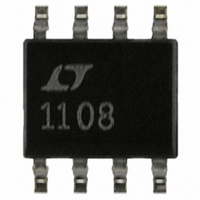LT1108CS8 Linear Technology, LT1108CS8 Datasheet - Page 6

LT1108CS8
Manufacturer Part Number
LT1108CS8
Description
IC DC/DC CONV ADJUSTBL OUT 8SOIC
Manufacturer
Linear Technology
Type
Step-Down (Buck), Step-Up (Boost), Invertingr
Datasheet
1.LT1108CS8PBF.pdf
(12 pages)
Specifications of LT1108CS8
Internal Switch(s)
Yes
Synchronous Rectifier
No
Number Of Outputs
1
Voltage - Output
Adjustable
Current - Output
400mA
Frequency - Switching
19kHz
Voltage - Input
2 ~ 30 V
Operating Temperature
0°C ~ 70°C
Mounting Type
Surface Mount
Package / Case
8-SOIC (3.9mm Width)
Power - Output
500mW
Lead Free Status / RoHS Status
Contains lead / RoHS non-compliant
Available stocks
Company
Part Number
Manufacturer
Quantity
Price
Part Number:
LT1108CS8
Manufacturer:
LINEAR/凌特
Quantity:
20 000
Part Number:
LT1108CS8#PBF
Manufacturer:
LINEAR/凌特
Quantity:
20 000
Part Number:
LT1108CS8#TRPBF
Manufacturer:
LINEAR/凌特
Quantity:
20 000
Company:
Part Number:
LT1108CS8-12
Manufacturer:
LT
Quantity:
10 000
Part Number:
LT1108CS8-12
Manufacturer:
LINEAR/凌特
Quantity:
20 000
Part Number:
LT1108CS8-12#PBF
Manufacturer:
LINEAR/凌特
Quantity:
20 000
LT1108
A
INDUCTOR SELECTION
General
A DC/DC converter operates by storing energy as mag-
netic flux in an inductor core, and then switching this
energy into the load. Since it is flux, not charge, that is
stored, the output voltage can be higher, lower, or oppo-
site in polarity to the input voltage by choosing an appro-
priate switching topology.
To operate as an efficient energy transfer element, the
inductor must fulfill three requirements. First, the induc-
tance must be low enough for the inductor to store adequate
energy under the worst case condition of minimum input
voltage and switch-ON time. The inductance must also be
high enough so maximum current ratings of the LT1108
and inductor are not exceeded at the other worst case
condition of maximum input voltage and ON-time.
Additionally, the inductor core must be able to store the
required flux; i.e., it must not saturate . At power levels
generally encountered with LT1108 based designs, small
surface mount ferrite core units with saturation current
ratings in the 300mA to 1A range and DCR less than 0.4
(depending on application) are adequate.
Lastly, the inductor must have sufficiently low DC resis-
tance so excessive power is not lost as heat in the windings.
An additional consideration is Electro-Magnetic Interfer-
ence (EMI). Toroid and pot core type inductors are recom-
mended in applications where EMI must be kept to a
minimum; for example, where there are sensitive analog
circuitry or transducers nearby. Rod core types are a less
expensive choice where EMI is not a problem. Minimum
and maximum input voltage, output voltage and output
current must be established before an inductor can be
selected.
Step-Up Converter
In a step-up, or boost converter (Figure 1), power generated
by the inductor makes up the difference between input and
output. Power required from the inductor is determined by
6
PPLICATI
P
L
V
OUT
O
V
U
D
S
–
V
I FOR ATIO
IN MIN
U
I
OUT
W
U
( )
01
where V
Energy required by the inductor per cycle must be equal or
greater than
in order for the converter to regulate the output.
When the switch is closed, current in the inductor builds
according to
where R' is the sum of the switch equivalent resistance
(0.8
When the drop across the switch is small compared to V
the simple lossless equation
can be used. These equations assume that at t = 0,
inductor current is zero. This situation is called “discontinu-
ous mode operation” in switching regulator parlance.
Setting “t” to the switch-ON time from the LT1108 specifi-
cation table (typically 36 s) will yield I
and V
end of the switch-ON time can be calculated as
E
the required power. For best efficiency I
to 1A or less. Higher switch currents will cause excessive
drop across the switch resulting in reduced efficiency. In
general, switch current should be held to as low a value as
possible in order to keep switch, diode and inductor losses
at a minimum.
As an example, suppose 12V at 30mA is to be generated
from a 2V to 3V input. Recalling equation (01),
L
must be greater than P
E
P f
I t
I
P
L
L
L OSC
L
L
( )
IN
/
typical at 25 C) and the inductor DC resistance.
t
. Once I
D
2
1
12
is the diode drop (0.5V for a 1N5818 Schottky).
LI
V
V
R
V
L
IN
IN
PEAK
2
'
PEAK
t
0 5
1
.
–
e
is known, energy in the inductor at the
V
– '
–
R t
L
2
L
V
/f
OSC
30
for the converter to deliver
mA
PEAK
PEAK
315
for a specific “L”
mW
should be kept
( )
( )
( )
( )
( )
02
03
04
05
06
IN
,














